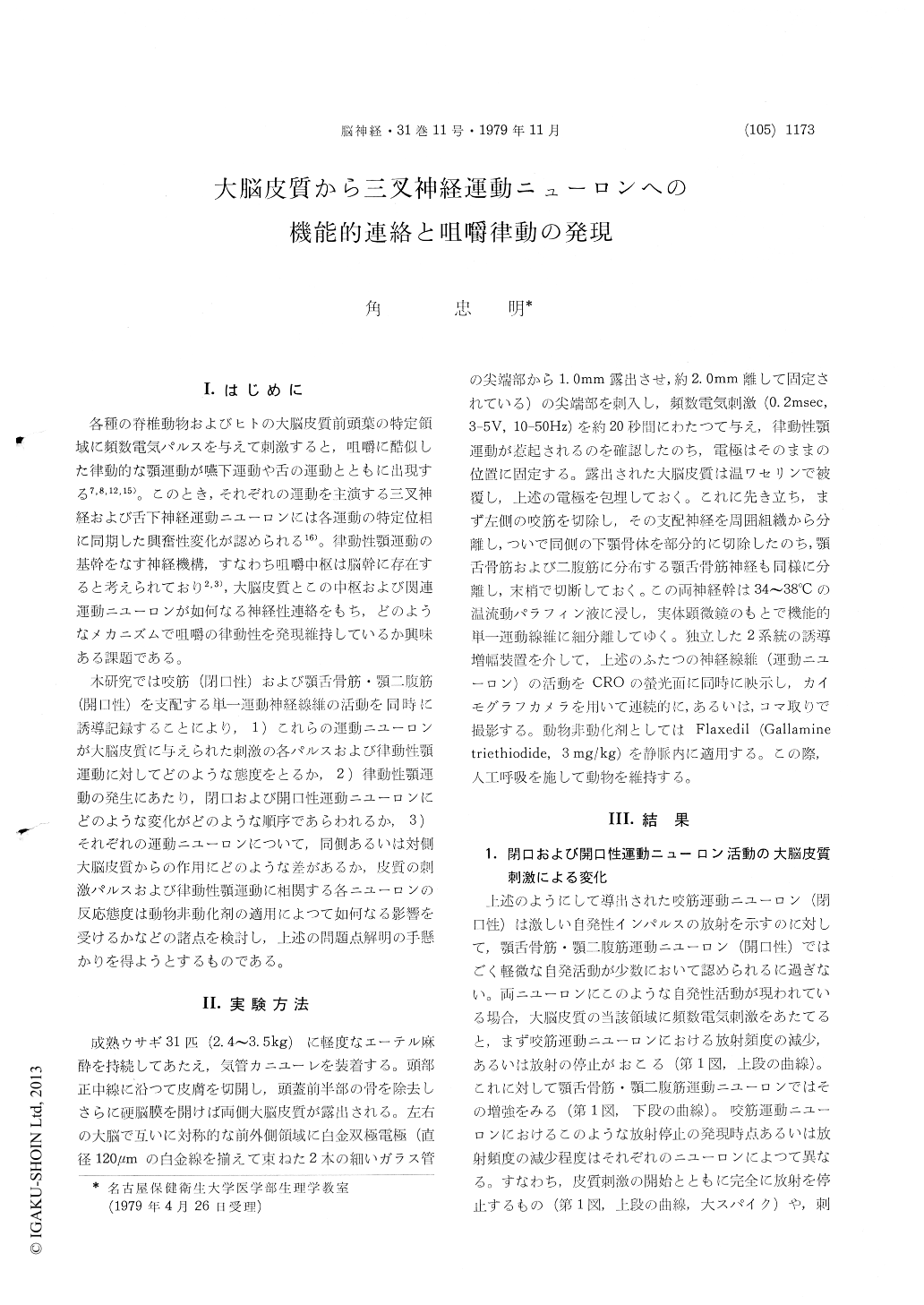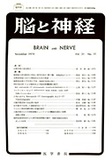Japanese
English
- 有料閲覧
- Abstract 文献概要
- 1ページ目 Look Inside
I.はじめに
各種の脊椎動物およびヒトの大脳皮質前頭葉の特定領域に頻数電気パルスを与えて刺激すると,咀嚼に酷似した律動的な顎運動が嚥下運動や舌の運動とともに出現する7,8,12,15)。このとき,それぞれの運動を主演する三叉神経および舌下神経運動ニユーロンには各運動の特定位相に同期した興奮性変化が認められる16)。律動性顎運動の基幹をなす神経機構,すなわち咀嚼中枢は脳幹に存在すると考えられており2,3),大脳皮質とこの中枢および関連運動ニユーロンが如何なる神経性連絡をもち,どのようなメカニズムで咀嚼の律動性を発現維持しているか興味ある課題である。
本研究では咬筋(閉口性)および顎舌骨筋・顎二腹筋(開口性)を支配する単一運動神経線維の活動を同時に誘導記録することにより,1)これらの運動ニユーロンが大脳皮質に与えられた刺激の各パルスおよび律動性顎運動に対してどのような態度をとるか,2)律動性顎運動の発生にあたり,閉口および開口性運動ニユーロンにどのような変化がどのような順序であらわれるか,3)それぞれの運動ニユーロンについて,同側あるいは対側大脳皮質からの作用にどのような差があるか,皮質の刺激パルスおよび律動性顎運動に相関する各ニユーロンの反応態度は動物非動化剤の適用によつて如何なる影響を受けるかなどの諸点を検討し,上述の問題点解明の手懸かりを得ようとするものである。
In lightly anesthetized adult rabbits, antero-lateral areas of the frontal cerebral cortex were stimulated with repetitive electrical pulses (0.2 msec, 1-8 V and 10-50 Hz) while the unitary efferent activities of the masseteric and the mylohyoid (innervating both the mylohyoid and the digastric muscles) nerves were recorded simul-taneously. For each gnatho-motor neuron, their behaviors relating to rhythmic jaw movements induced by cortical stimulation and to each cortical stimulus involved were analysed.
Under no cortical stimulation, hence the jaw remained at rest, the masseteric motoneurons showed remarkable activities, whereas the mylo-hyoid-digastric did none, if any, only a few. Preceding the onset of rhythmic jaw movements by cortical stimulation, the masseteric motoneurons reduced first their spontaneous activity and became completely silent, whereas the mylohyoid-digastric motoneurons showed at first an increase of the activity that led to the first burst of impulses of masticatory rhythm. Thereafter, the massetericand the mylohyoid-digastric motoneurons displayed their activities rhythmically and reciprocally. From the criteria that whether the masseteric and the mylohyoid-digastric motoneurons responded to each electrical pulse of the cortical stimulation and whether they showed rhythmic activity in phase with jaw movements, four types were distinguished ; 1) the motoneurons discharging solely with masti-catory rhythm, 2) the motoneurons correlated both with masticatory rhythm and with each cortical stimulus, 3) the motoneurons correlated solely with each cortical stimulus, and 4) the motoneurons correlated neither with cortical stimulus nor with masticatory rhythm. The nature and the grade of response to ipsi or contralateral cortical stimulus was similar in the masseteric motoneurons, whereas differed greatly in the mylohyoid-digastric motoneurons, in which an excitation from contra-lateral side was exclusively predominant. These behaviors of the masseteric and the mylohyoid-digastric motoneurons were essentially unchanged after motoparalysis induced by administration of gallamine triethiodide. Based on these findings, the mode of corticifugal connection between the frontal cortex and the trigeminal motoneurons was postulated, and the process contributing to the generation and maintenance of the masticatory rhythm was discussed.

Copyright © 1979, Igaku-Shoin Ltd. All rights reserved.


